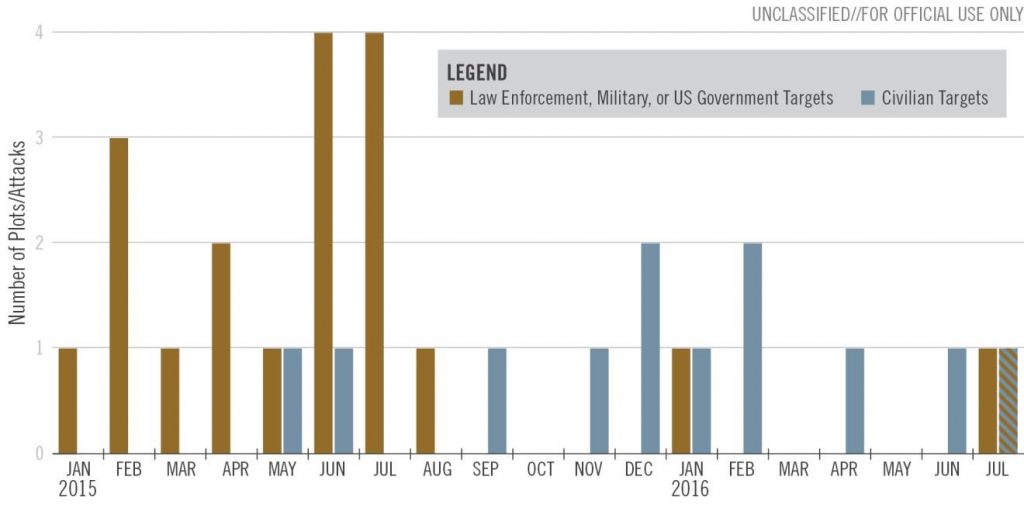
A chart from the August 2016 bulletin issued by the Department of Homeland Security, FBI, and National Counterterrorism Center (NCTC) shows the increasing number of plots focusing on civilian targets.
A joint intelligence bulletin issued in late August by the Department of Homeland Security, FBI, and National Counterterrorism Center (NCTC) assesses that homegrown violent extremists (HVEs) are “increasingly favoring civilian targets” as part of a wider “variety of targeting choices.” Previous assessments have found that HVEs are most likely to prioritize attacks on “law enforcement personnel, military members, and US Government-associated targets.” However, a recent shift towards civilian targets has likely been driven by the accessibility of “soft targets” that are often less secure than government facilities and provide greater opportunities for conducting mass casualty attacks.
Over the last year, seventy-seven percent of the “thirteen HVE attacks and disruptions . . . focused on civilian targets, in contrast to eleven percent of the eighteen HVE attacks and disruptions in the first seven months of 2015.” Three separate HVE plots in 2016 targeted religious institutions, the “first such cases since a 2009 plot against a New York-based synagogue” according to the bulletin. Since 2015, HVEs have “plotted against or attacked restaurants, a nightclub, a concert, a public ceremony, a place of employment, and a college classroom, demonstrating the variety of targeting choices.” The bulletin was issued prior to the recent bombings in New York and New Jersey which also targeted civilian locations including a train station, charity race, and numerous public streets.
The bulletin states that a combination of factors ranging from “perceived lower levels of security” as well as “violent extremist messaging glorifying recent attacks on civilians” have motivated this shift in tactics. The bulletin also highlights a newer trend which has led HVEs to select “familiar targets of personal significance to simplify plotting,” often capitalizing on preexisting grievances or a desire for revenge. This is particularly relevant to cases such as the December 2015 attack on the Inland Regional Center in San Bernardino, during which Syed Rizwan Farook and his wife Tashfeen Malik killed fourteen people at a training event and Christmas Party hosted by the San Bernardino County Department of Public Health. Farook, who worked for the county as a health inspector, had been attending the event earlier in the day prior to conducting the attack. In another example cited in the bulletin, an eighteen-year-old freshman at the University of California at Merced named Faisal Mohammad stabbed a classmate and three other individuals at the college before being shot by a campus police officer. The FBI later stated that Mohammad had been viewing extremist material online and they believe the attack was inspired by the Islamic State of Iraq and the Levant (ISIL).
To help prevent HVE attacks, the bulletin recommends that state and local authorities be vigilant and “report suspicious activities related to potential mobilization to violence in the Homeland by US-based individuals inspired by foreign terrorist organizations.”
